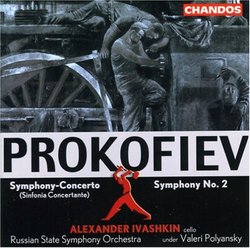| All Artists: Sergey Prokofiev, Valery Polyansky, Russian State Symphony Orchestra Title: Prokofiev: Symphony-Concerto; Symphony No. 2 Members Wishing: 0 Total Copies: 0 Label: Chandos Release Date: 7/23/2002 Genre: Classical Styles: Forms & Genres, Concertos, Historical Periods, Modern, 20th, & 21st Century, Instruments, Strings, Symphonies Number of Discs: 1 SwapaCD Credits: 1 UPC: 095115998922 |
Search - Sergey Prokofiev, Valery Polyansky, Russian State Symphony Orchestra :: Prokofiev: Symphony-Concerto; Symphony No. 2
 | Sergey Prokofiev, Valery Polyansky, Russian State Symphony Orchestra Prokofiev: Symphony-Concerto; Symphony No. 2 Genre: Classical |
Larger Image |
CD Details |
CD ReviewsA Fine but Neglected Symphony Thomas F. Bertonneau | Oswego, NY United States | 09/01/2003 (5 out of 5 stars) "Sergey Sergeyevich Prokofiev (1891 - 1953) wrote one of the most popular of Twentieth Century symphonies, his Fifth (1944), which has enjoyed many recordings from the halcyon days of the monophonic long-playing vinyl record to the compact-disc era; Prokofiev?s Sixth (1947) and Seventh (1952) Symphonies have also maintained an audience, as has his First (1917), the "Classical." The Second, Third, and Fourth, on the other hand, have attracted rather less attention than their younger siblings. This is due, in part, to a fearsome reputation, especially in the cases of the Second (1924) and the Third (1927), for implacable dissonance and massive orchestration. A typical description of the Second Symphony is as follows (the source is Robert Layton writing in Robert Simpson's 1960s Penguin survey of "The Symphony," Volume Two): "The first movement almost gives the impression of being a sustained fortissimo relieved only by an occasional forte... In the first movement, at any rate, it would seem that Prokofiev were trying to compete in sheer orchestral violence with the Honegger of Horace Victorieux and the style mecanique - and succeeding." Says Layton, "certainly in its complexity and density of orchestra texture, fecundity of detail, bold use of dissonance and its exuberance, it can challenge comparison with the most audacious scores of the twenties." Layton's description of the first of the symphony's two movements is largely accurate - and the reference to Honegger is appropriate, as long as one remembers that Honegger's Pacific 231 is "dissonant" and massively orchestrated. The First Movement ("Allegro Ben Articulato") of Prokofiev?s Second Symphony strongly resembles "Pacific 231" on a larger scale: it has the same machine rhythms, the same "steely" and relentless character; but like Pacific 231 it is thoroughly engaging musically and would work well, for example, as a musical background to the subterranean scenes of Fritz Lang's silent-era science fiction film "Metropolis." The long Second Movement (nearly a half an hour) carries the designation of a "Theme and Variations." Here, Prokofiev moderates the harmonic astringency and adjusts the dynamic level; in so doing, he conjures music aptly described by the adjective "muscular" while being at the time melodious and serene. Valery Polyansky conducts a reading of this score that clarifies its dense, polyphonic textures without defusing the steel-mill atmosphere. I am sure that the Second Symphony has had several recordings over the years - but the only one that I remember is from a set of the symphonies with the French Radio Orchestra under Jean Martinon released on Vox in the mid-1960s. Polyansky and his Russian orchestra are a decided improvement over that older recording. In the Sinfonia Concertante (1948), Polyansky and his musicians team up with cellist Andrei Ivashkin. The Sinfonia Concertante corresponds to Prokofiev's mellow late style, although it has its roots in a much-revised Cello Concerto of the early 1930s. The locus classicus of this score is Rostropovich on EMI Melodiya, from the days of the stereo LP; the current catalogue lists a number of fine versions - with Truls Mork, Mischa Maisky, and Alexander Rudin in the solo role. Ivashkin is anyone's equal and his gutsy, subtly articulated sound is served well by the Chandos engineers. Yet the main reason for buying this disc - which I strongly recommend - is the Second Symphony, which receives its finest representation to date."
|
